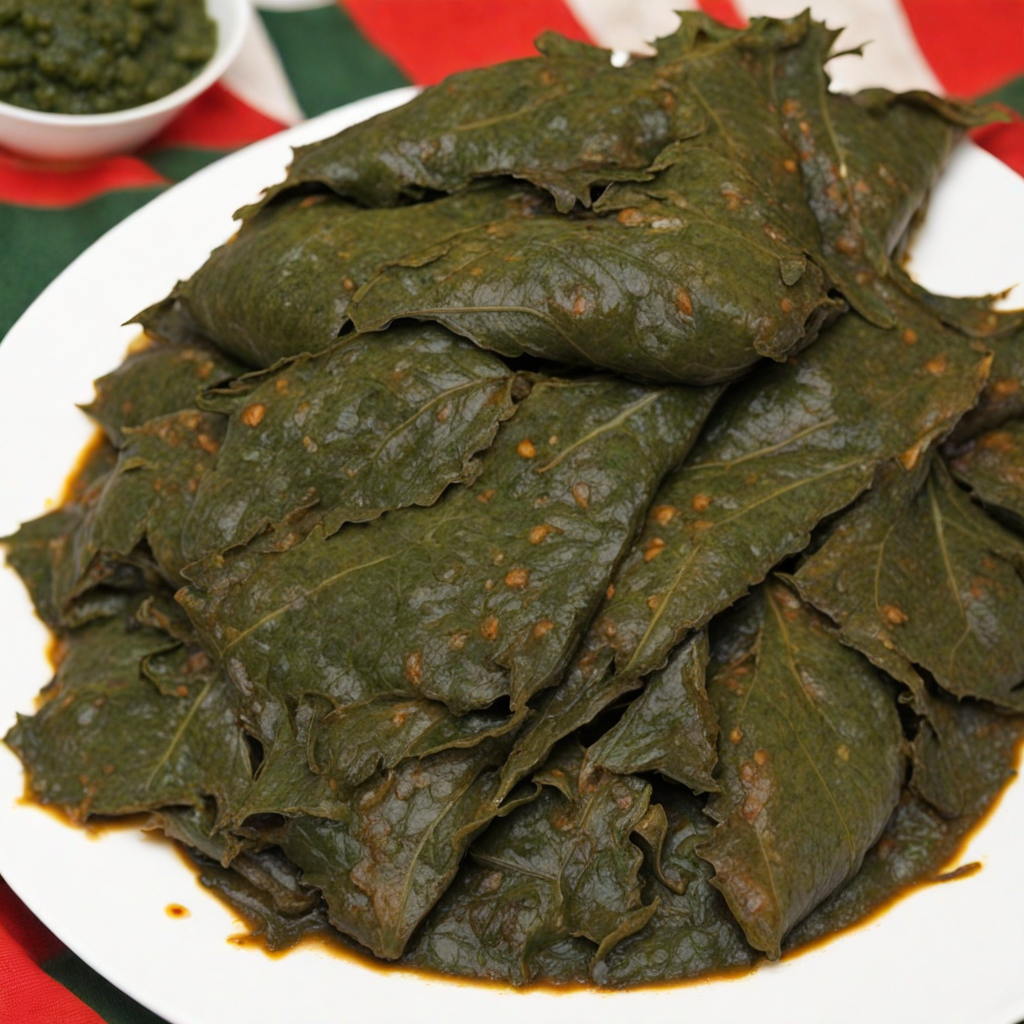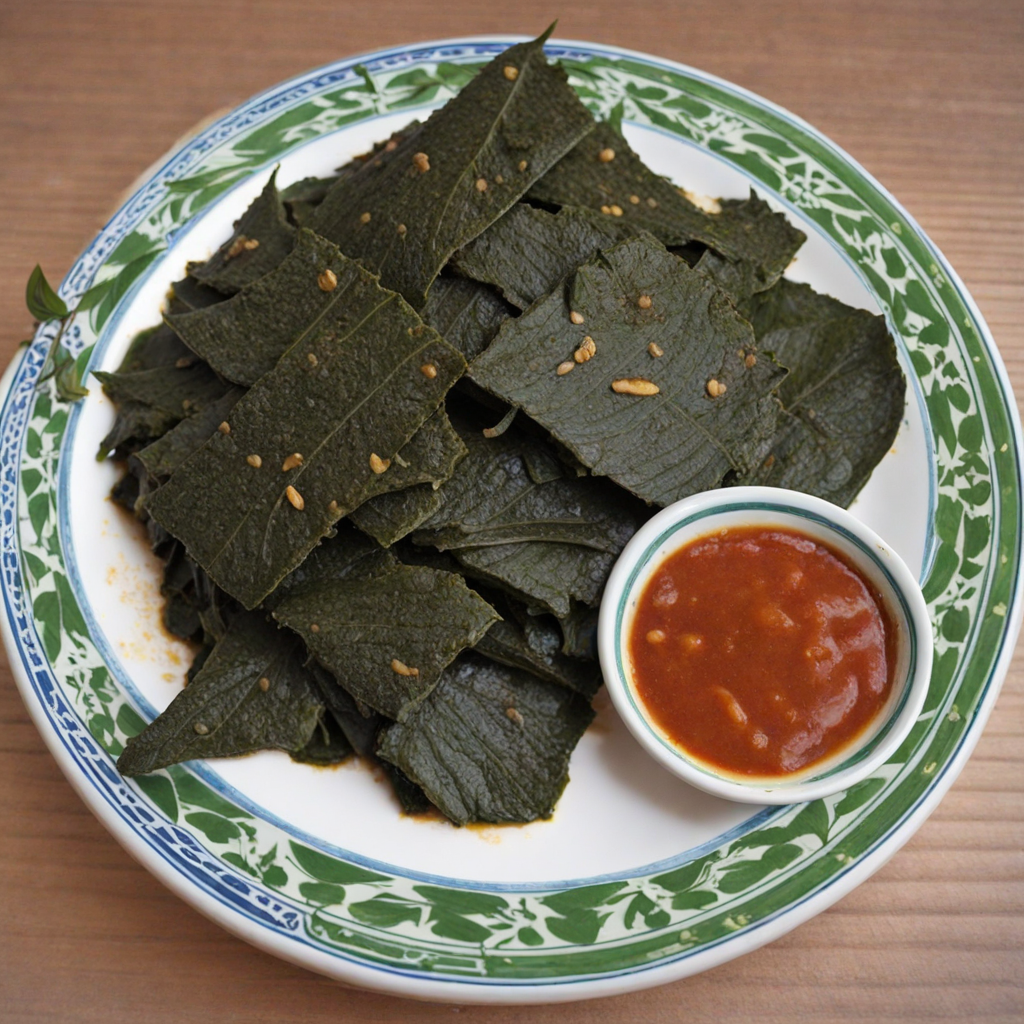Cassava Leaves
Cassava leaves, known as "saka saka" in Burundi, are a vibrant and nutritious ingredient that brings a unique taste to the table. The leaves of the cassava plant are typically harvested when they are young and tender, imparting a slightly earthy flavor with a hint of bitterness that becomes mellow when cooked. This leafy green is often simmered until tender, allowing its natural flavors to develop while absorbing the seasonings used in the dish. The texture is soft yet slightly fibrous, providing a delightful contrast to the other components of the meal. In Burundian cuisine, cassava leaves are frequently prepared with a variety of ingredients such as ground peanuts or palm oil, which enrich the dish with creaminess and depth. The addition of spices and aromatics like onions, garlic, and chili peppers elevates the overall flavor profile, resulting in a hearty and satisfying dish that can be enjoyed on its own or as a side to complement rice, plantains, or meat dishes. The combination of these flavors creates a symphony of tastes that is both comforting and invigorating. Moreover, cassava leaves are not only delicious but also packed with nutrients, making them a wholesome choice for those seeking new culinary experiences. Rich in vitamins A and C, as well as protein, they provide essential health benefits while introducing a new dimension to your palate. Exploring the taste of cassava leaves opens up an authentic glimpse into Burundian culture and its culinary traditions, making it a must-try for adventurous food lovers looking to expand their horizons.
How It Became This Dish
Isombe: A Culinary Treasure of Burundi Isombe is a traditional dish from Burundi, a small, landlocked country in East Africa, known for its rich cultural heritage and diverse culinary landscape. At its core, Isombe is a dish made primarily from cassava leaves, often cooked with ground peanuts and served with a variety of accompaniments, such as rice or plantains. This dish, while simple in its ingredients, embodies the essence of Burundian culture and offers a window into the historical and social dynamics of the region. Origins of Isombe The roots of Isombe can be traced back to the agricultural practices of the Bantu people, who migrated to the Great Lakes region of Africa over a thousand years ago. Cassava, a drought-resistant plant, became a staple crop due to its adaptability to the local climate and soil conditions. It was during this period that the use of cassava leaves in cooking began to take shape, leading to the creation of Isombe. The preparation of Isombe involves harvesting young cassava leaves, which are then washed, boiled, and often pounded to soften their texture. Ground peanuts are added to provide richness and flavor, creating a harmonious blend that highlights the earthiness of the leaves. This dish is not just a product of agricultural necessity but also a reflection of the communal values inherent in Burundian society. Traditionally, families would gather to prepare Isombe, fostering a sense of togetherness and shared identity. Cultural Significance Isombe holds a prominent place in the culinary traditions of Burundi. It is often served during celebrations, communal gatherings, and important life events, such as weddings and festivals. The act of preparing and sharing Isombe transcends mere sustenance; it is an expression of hospitality and a way to strengthen social bonds. In Burundian culture, food is a vital component of community life, and Isombe serves as a culinary symbol of unity. Moreover, Isombe is not just a beloved dish but also a representation of the resilience of Burundians. The country has faced numerous challenges, including political unrest and economic hardships, yet the culinary traditions have endured. Isombe, made from readily available ingredients, symbolizes self-sufficiency and the ability to thrive in adversity. It is also a dish that connects Burundians to their agrarian roots, reminding them of the importance of sustainable farming practices and local produce. Development Over Time As Burundi has evolved through the centuries, so too has the preparation and presentation of Isombe. Historically, the dish was prepared using traditional methods, often involving communal cooking over open fires. The ingredients were sourced from local gardens and farms, reflecting the seasonal changes and agricultural practices of the time. However, with urbanization and globalization, the way Isombe is prepared and consumed has begun to shift. In urban areas, where access to fresh cassava leaves may be limited, some Burundians have turned to frozen or canned alternatives. This adaptation has allowed Isombe to remain a staple in modern households, while still retaining its traditional essence. Additionally, as the diaspora of Burundians has spread across the globe, Isombe has found its way onto international menus, introducing the dish to a wider audience. Despite these changes, many families still prioritize the traditional approach to cooking Isombe, viewing it as a way to preserve their cultural identity. In rural areas, the preparation remains largely unchanged, with families continuing to grow their own cassava and peanuts. This practice not only sustains the dish but also reinforces the connection to their agricultural heritage. Isombe in Contemporary Burundi Today, Isombe continues to be a beloved staple in Burundian cuisine, often accompanied by various side dishes that enhance its flavor profile. Common pairings include broiled fish, grilled meat, or a simple serving of rice. The versatility of Isombe allows it to be enjoyed in many forms, whether as a comforting home-cooked meal or as part of a lavish banquet. In recent years, there has also been a growing interest in healthy eating and the nutritional benefits of traditional foods. Isombe, rich in vitamins and minerals, has gained recognition as a nutritious option, appealing to health-conscious consumers. This shift has prompted some chefs and home cooks to experiment with new interpretations of Isombe, incorporating modern cooking techniques and flavors while remaining true to its roots. Conclusion Isombe is more than just a dish; it is a vibrant representation of Burundian culture, history, and community. Its origins are deeply intertwined with the agricultural practices of the past, while its cultural significance continues to resonate in the present. As Burundi navigates the complexities of modern life, Isombe remains a cherished culinary tradition, celebrating resilience, unity, and the enduring bonds of family and community. Through Isombe, individuals are reminded of their roots and the importance of food in nurturing relationships and cultural heritage. Whether enjoyed in a bustling city or a rural village, Isombe embodies the spirit of Burundi, inviting all who partake in it to savor the flavors of a rich and storied past, while looking forward to a future where culinary traditions continue to thrive.
You may like
Discover local flavors from Burundi







